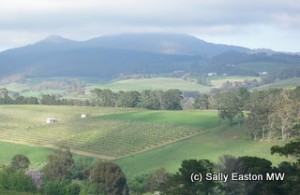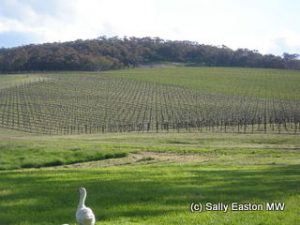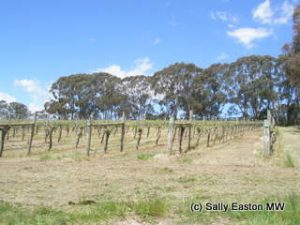Orange – the new black?
Orange is about three and a half hours’ drive west of Sydney, over the Blue Mountains of the Great Dividing Range. This makes it something of a weekend destination, which it’s well served to achieve, as Orange town, of about 40,000 people, is already becoming a food and wine mecca. There are a handful of high quality restaurants, including Lolli Redini and Racine, just outside the town, as well as more bistro-style offerings.

Canobolas in cloud
Locals also make a big deal about having four distinct seasons to Sydney’s ‘two-season subtropical’ climate. Indeed ‘Brand Orange’ runs four big promotional events a year – one to coincide with each season.
It helps that Orange town, lying at 850m, has some attractive ‘old money’ heritage and architecture in its gold rush origins. Streets are broad and wide enough for the turning circle of an ox and cart, which means parking is usually no problem.
Wine is the newcomer to Orange … the region used to be one of the biggest apple producing centres in Australia, and it still ranks nearly up there. The region is also a big pear and cherry producer, among the more familiar livestock and cereal production.
But no citrus. Orange was named by New South Wales’ surveyor general, Thomas Mitchell, in honour of his friend, Willem (William), Prince of Orange. They had fought together in the Peninsular War (1808 to 1814) against Napoleon. Willem went on to become king of the Netherlands.
For wine, the Orange region, lying on the elevated central tablelands west of the Great Dividing Range is the only geographical indication (GI) in Australia to be defined by altitude – contiguous land above 600m around the extinct volcano that dominates the skyline, Mount Canobolas, at 1,396m. Vineyards below 600m fall into the Central Ranges zone.
Mount Canobolas is to the south west of nearby Orange town, and just 20 kilometres west of the mountain, elevation drops away quite rapidly.
Cool climate
Orange falls into a cool climate classification. Halliday’s Wine Atlas of Australia (2006) cites heat degree days (HDD) as 1200 to 1309, with an MJT (mean January temperature) of 19.9°C. The HDD put Orange in Winkler and Amerine’s Region I, though the MJT just squeezes the boundary into region II, by as small a margin as is possible.
However, with vineyard altitudes ranging from 600m to 1050m, a wide range of meso-climates exist in the region. Official Orange literature cites MJT as ranging from 20.9°C at 600m to 19°C above 1,000m, so the upper reaches of the GI are pretty cool.

Mayfield Vineyard
It’s a tiny region with around 1,500 hectares (ha) of vines – less than 1% of the national total, and mostly planted to the usual suspects: shiraz, cabernet sauvignon, merlot, pinot noir, chardonnay, sauvignon blanc and riesling, along with some tempranillo and viognier. Production is currently about 60% red, 40% white, and this looks set to reverse as this young region realises its potential for aromatic and semi-aromatic whites. It’s already beginning to produce some really interesting and notably classy wines.
There are around 50 vineyards, and mostly producers are small, with the notably exception of Cumulus, mostly owned by a Portuguese investment company with several wine investments. Cumulus has 500 ha , making it the 7th largest contiguous vineyard in Australia.
Pioneers include Bloodwood, who first planted in 1983, and now have 8 ha of vineyard, and Canobolas-Smith, both of whom make wine on site.
Philip Shaw, while he was working for Rosemount, bought his Koomooloo site in 1989, some 900m above sea level. He’d spent a handful of years looking for somewhere to plant pinot noir and chardonnay, and he now has 47 ha in total. The apple orchard status helped Shaw make up his mind about the vineyard, as he said “to get good colour in apple skins, you need a certain cold period,” which he explained was also important for grape growing.
Along with a couple of others, that was pretty much it for a while, until a relatively huge amount of vineyard started going in from the mid 1990s.
Altitude
Altitude is worn like a badge of honour in Orange, and Mayfield Vineyard, at 860 to 930m, claims status of ‘one of the highest and coolest vineyards in Australia’. Owners Richard and Kathy Thomas commissioned a thorough study before investing in the property, and planting it in 1998. Thomas said “there are not many days over 30°C in summer.” Even higher, with vineyards up to 1,000m, is Brangayne, where owner David Hoskins said “the January average is 26°C, and it can go below 10°C at night.”
Thomas said this high diurnal temperature variation “maintains the natural acid backbone. I think it enhances flavour through gradual flavour development.” Hoskins added “Fruit is on the vine longer. Post veraison flavour development is not rushed by heat. And sugar accumulation here is slower.“

Brangayne
Another consideration of such a wide variance in altitude over a short distance is that it rather dictates plantings. Pinot noir on the lower slopes struggles (too warm), as does sauvignon blanc, as does cabernet sauvignon on the upper slopes (too cool).
Phil Kerney makes some of the Mayfield wines at the Wallace Lane Wine Company, which was established in 2009 by Ross Hill wines, as a contract winemaking facility. An old apple storage shed was converted into a winery in an attempt to keep more Orange fruit in the region, rather than see it exported to contract winemakers further afield, which is the common current practice, as many growers are just that.
Kerney is also the winemaker for Ross Hill Wines, which was started in 1994 by Peter and Terri Robson, who originally sold fruit to the big boys. They bought the Wallace Lane property in 1998, and, as well as converting the apple shed, have planted pinot grigio, sauvignon blanc, and pinot noir here, at over a 1,000m.
Neighbouring Wallace Lane and the higher altitude Ross Hill vineyard, at 970m, is Brangayne, named after the handmaiden of Isolde in Wagner’s opera Tristan and Isolde, which had been a favourite opera of Hoskins’ grandmother, who had founded the property in the 1930s.
Brangayne’s vineyards lie on the north-east slopes of Mount Canobolas. It was not until 1994 that fruit orchards were replaced by vines. As befitting the altitude, the 26 ha are planted to chardonnay, sauvignon blanc, riesling, pinot grigio, pinot noir, pinot meunier, as well as cabernet sauvignon, shiraz and merlot on their lower vineyard, at 870m. Hoskins said “we’re still a young region, and we’ve been grappling with an ‘Orange style’.” For example, he said “it’s only in the last five years that people have cottoned to shiraz and cabernet sauvignon. We do them better than people thought”
Borrodell is another of the high altitude properties at 1,100m. It’s all basalt country on the top slopes, where aromatic whites do best. Hail is an issue, so the property’s cherry and apple orchards are netted for protection.
Apart from such smaller family holdings, and Cumulus at the opposite end of the spectrum, there are one or two medium sized operations, for example Angullong, owned by the Crossing family, where 220 hectares were planted between 1998 and 2000, on their much larger sheep and cattle farm. The vines occupy altitudes of 580m to 620m, so only those vineyards above 600m supply fruit for Orange-labelled wines. The same applies for Cumulus.
There is a lightness and elegance of style to many of the wines here, which sets them apart from warmer regions in Australia. And though, said Shaw, “it’s in the last three years that quality has increased tremendously, if we do get challenged it’s because our wines are not over-expressive at an early age.“ And more potential will be released as producers invest in their own wineries and winemakers, taking full control of not just grape growing, but also winemaking.
My research visit to Australia in October 2010 was sponsored by Wine Australia.



